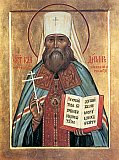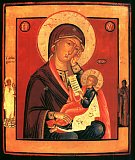

| Previous day | Next day |
| Old Style
January 25
|
Friday |
New Style
February 7
|
|
34th Week after Pentecost.
Tone 8.
Fast Day. |
Fish, wine and oil allowed.
|
![]() St. Gregory the Theologian, archbishop of Constantinople (389). St. Anatole I (Zertsalov), elder, of Optina Monastery (1894).
St. Gregory the Theologian, archbishop of Constantinople (389). St. Anatole I (Zertsalov), elder, of Optina Monastery (1894). ![]() New Hieromartyr Vladimir, metropolitan of Kiev, protomartyr of the Communist yoke in Russia (1918).
New Hieromartyr Vladimir, metropolitan of Kiev, protomartyr of the Communist yoke in Russia (1918).
Martyrs Felicitas of Rome and seven sons: Januarius, Felix, Philip, Silvanus, Alexander, Vitalis, and Martial (ca. 164). St. Publius, ascetic, of Euphratensis in Syria (ca. 380). St. Mares the Singer, of Omeros near Cyrrhus (ca. 430). St. Moses, archbishop of Novgorod (1362). St. Gregory, abbot, of Staro-Golutvin Monastery and bishop of Kolomna (15th c.).
New Hieromartyrs Peter (Zverev), archbishop of Voronezh (1929) and Basil (Zelentsov), bishop of Priluki (1930). New Martyr Abbess Margaret (Gunaronulo) of Menzelino (1918). New Martyr Athanasia (Lepeshkin), abbess of the Smolensk Hodigitria Convent, near Moscow (1931).
Icons of the Most Holy Theotokos “Assuage My Sorrow” and “Unexpected Joy.” (1640)
St. Castinus, bishop of Byzantium (240). St. Bretanion (Vetranion), bishop of Tomis in Moesia (ca. 380). St. Apollo of the Thebaid, monk (4th c.). Hieromartyr Praejectus, bishop of Clermont (676). St. Demetrius, the skevophylax (“keeper of the sacred vessels”), of Constantinople (8th c.). New Martyr Auxentius of Constantinople (1720). St. Gabriel, bishop of Imereti (Georgia) (1896).
Repose of Archpriest Sergius Orlov of Akulovo (1975).
Thoughts for Each Day of the Year
According to the Daily Church Readings from the Word of God
By St. Theophan the Recluse

Friday. [II Pet. 1:1–10; Mark 13:1–8]
Having enumerated the virtues which we must seek with all diligence, having received grace-filled power, the Apostle says by way of encouragement, If these things be in you, and abound, they make you that ye shall neither be barren nor unfruitful in the knowledge of our Lord Jesus Christ (II Pet. 1:8). The virtues to which he refers here were mentioned in I Pet. 2:21–3:9. Now we shall add only that we are required to manifest these virtues not just once, but rather to make them always abide in us, to be part of our essence, to take root in us. Thus, they must not remain on one level, but ever multiply and grow in strength and fruitfulness. Only then, he says, will you not be barren and unfruitful in the knowledge of our Lord Jesus Christ (II Pet. 1:8). He who believes in Him and confesses Him enters into the knowledge of the Lord. “You believe?” says the Apostle! See then, that your faith be not barren and unfruitful. What should I do, so that my faith will not be that way? Prosper in every virtue. Where are those who repeat over and over that believing is enough: that nothing more is needed?! Whoever thinks this way is blind.
Articles
 Venerable Anatole I of OptinaFrom a very early age, Alexis wanted to become a monk. He even thought about going to the Roslavl forests to live with the hermits at that place. |
 St. Vladimir, Metropolitan of Kiev and GallichThe holy Metropolitan Vladimir of Kiev was the first bishop to be tortured and slain by the Communists at the time of the Russian Revolution. |
 St. Publius the Ascetic of SyriaSaint Publius of Syria was born in the city of Zeugma on the Euphrates and was a senator. |
 St. Mares the Singer in SyriaSaint Mares the Singer lived in a hut in fasting and prayer for thirty-seven years in the village of Homeron, not far from the city of Cyrrhus in Syria. |









